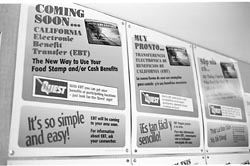|
EBT: A More Humane Way to Offer Benefits In Spite of Citibank Fiasco
December 2002 magine you are a food stamp recipient. When you come to the check- out line of the grocery store, instead of paying with cash, check, or credit card you produce a bunch of coupons which announce to the checker and everyone else in sight that you receive public assistance. The coupons are also messy to deal with, and slow everything down. Under a new pilot system, recipients are given a debit card which they can use like any bank card, without drawing attention to their economic situation. At least that was the theory behind the Electronic Benefit Transfer card. However, workers complain that the vendor Citibank produced a system that is full of bugs, and left the county and workers to clean up their mess. Alameda is the pilot county, and chapter president Darlene White explained what workers have been going through. “The county never consulted with us, they said it was just a little something, no big deal. It will get rid of the forms, and be easy to use. It is just another clerical function,” she states. According to White the county originally told the workers that they would not have to take time from processing claims to show clients how to use the system, and that the EBT computer system would seamlessly take information from the case entered in the eligibility worker’s computer with a minimal amount of effort on the worker’s part. The data would then be used to produce cards similar to ATM cards, and the cards would be mailed to the clients within three days of applying for aid. These claims proved false, according to the eligibility workers who spoke out at the retreat. Just as the system went live, the workers were told that the county was in a pinch. Citibank had backed out of training the clients how to use the cards, and they expected the eligibility workers to take up the slack. Citibank was supposed to have a representative on hand for the first 30 days to help clients learn to use the new cards, but they backed out after the first week. Alameda County eligibility worker Cynthia Landry remembers that first week, “The line of people wanting help was backed up outside the building. The Citibank trainers were completely overwhelmed. Many of our clients have never used ATM cards before and then add to that literacy and language issues. You can understand all the problems we were having.” Bilingual workers are especially over-worked. Even when the EBT systems did interface, the system could not send out cards in a timely manner. “They told us it would take three days to get the cards, but what they didn’t tell us, was that was just to produce the cards. It can take 10 days before the client gets the card in the mail, and during that time they have no access to benefits and are calling us up wanting to know what happened,” White explains. Many of the welfare clients were in danger of running out of food or being unable to pay their rent. Once the clients received their cards their problems were far from over. A glitch in the system caused the computer to produce too many cards. It would issue a card, send it to the client, but before the client received the card, it would cancel that card and issue another card. So when finally the client was sent their card, the card wouldn’t work. When workers finally got through to Citibank, the help desk people would blame the workers for the problems, even though the case was entered into their computer correctly. “The case would look fine on my end of the system, but something would be wrong on their end, and they would blame us.” White states. Eventually workers were given access to the EBT terminals, but according to White this created even more problems. “They now want us to go into their system and trouble shoot the problem, but that means getting up from your desk and walking to a PC across the room or in a another room. And if the clerical workers who are working with the computer can’t resolve the problem, how can we?” Resolving client problems with the system is disrupting workflow. Normally a worker conducts an interview with a client during one part of the day and spends the other part of the day calculating the benefits and filling out the forms. Now whenever a client comes into the office and needs help with using the machine, the workers must interrupt their work and go out and help the client. To add insult to injury, Citibank now wants workers to sign liability forms stating that workers will be liable for anything that goes wrong with their system. The union is taking the position that workers should refuse to sign these forms. Technical difficulties aside, the clients we spoke with liked the anonymity and not having to deal with food stamp coupons or check cashing services. The main problems that Landry heard were that they can only get money out of the machines in $20 increments, and if there’s less than $20 in their account they have to go to a store and buy something minimal. If they use the wrong ATM machine they get billed $1.50 for the transaction, and they can’t afford it.
|
|||||||||


 The
task of explaining PIN numbers and how to use the ATM machines would have
been bad enough for the already over-worked eligibility workers, but add
to that the fact that the cards the system was generating didn’t work.
The Citibank software couldn’t communicate with the county’s system; the
two systems used different codes. At first the EBT system was unable to
issue any cards at all and workers had to hand generate them. It took
several weeks after the launch to resolve those problems and during that
time many clients were not receiving benefits.
The
task of explaining PIN numbers and how to use the ATM machines would have
been bad enough for the already over-worked eligibility workers, but add
to that the fact that the cards the system was generating didn’t work.
The Citibank software couldn’t communicate with the county’s system; the
two systems used different codes. At first the EBT system was unable to
issue any cards at all and workers had to hand generate them. It took
several weeks after the launch to resolve those problems and during that
time many clients were not receiving benefits. Eligibility
offices have the ability to generate cards on the spot, but soon after
the cards are given to the client the computer would invalidate that card,
and issue another one. The system is also unreliable and inaccurate in
the benefits it delivers. Citibank provides an 800 number, but when workers
and clients tried to call they would get a message instructing the caller
to contact the county social services agency if they need help.
Eligibility
offices have the ability to generate cards on the spot, but soon after
the cards are given to the client the computer would invalidate that card,
and issue another one. The system is also unreliable and inaccurate in
the benefits it delivers. Citibank provides an 800 number, but when workers
and clients tried to call they would get a message instructing the caller
to contact the county social services agency if they need help.